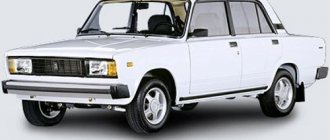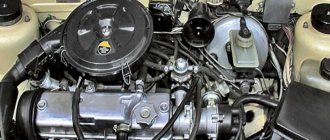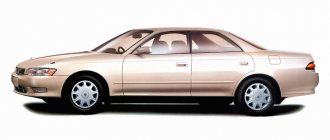Many owners of a VAZ 2109 with an injection engine have encountered a problem when the car begins to jerk and jerk, and traction is lost. This is a fairly common malfunction for all power units and injection systems. In this article we will analyze the main causes of the malfunction, as well as methods for solving the problem.
Characteristics
One of the most common cars in the CIS countries, the VAZ 2109, began to be produced back in 1988. Despite the already quite old age of this car model, it is still popular among the population of our country. The main difference between the VAZ 2109 and its predecessor 2108 is five doors instead of four and a more spacious body. The VAZ 2109 engine was also replaced. Thanks to these innovations, this car began to be positioned as a Soviet family car.
Download .xls file
xls
Download picture
Send by email
| OPTIONS | MEANING | |
| Fuel used in VAZ 2109 | Petrol | |
| Power supply to the motor | Carburetor | Distributed injection |
| Cylinder (its diameter in mm) | 82 | 82 |
| Piston stroke | 71 | 71 |
| Maximum compression rate | 9.9 | 9.9 |
| Fuel capacity (engine volume), cm 3 | 1499 | 1499 |
| Engine power, kW/rpm | 68/5600 | 78/5400 |
| Torque - maximum value, Nm at rpm | 100 / 3400 | 116 / 3000 |
| Gasoline standards | AI-92 | AI-95 |
| Waste on gasoline when driving in urban conditions, l/100km | 8.7 | 9.9 |
| Vehicle speed, km/h | 154 | 155 |
| Acceleration of a car to a speed of 100 km/h, s | 14 | 13 |
| Gearbox operation type | With manual control | |
| Transmission levels | 5 forward, 1 reverse | |
| Fuel tank capacity | 43 | 43 |
This motor is suitable for use in VAZ 2108 and VAZ 2109 cars.
Checking injectors and timing belt
When there is a spark and its color is bright bluish, check the fuel supply: turn out the injectors and turn the engine shaft with the starter. The fuel should be sprayed from the nozzle in a uniform cone-shaped “torch”. If instead the injector pours gasoline or splashes it, then it is clogged.
If the tested components are working, then look at the timing belt. Owners of the injection “nine” have more than once encountered the situation of the belt slipping by several teeth. In winter, this can happen when starting a cold engine when the camshaft rotates heavily. To check, look at the timing mark. If it matches, check the crankshaft sensor and its wire (sometimes it comes off). Then the remaining sensors are checked.
Description
The technical characteristics at that time were standard: a 1.1-liter engine, a carburetor in the mechanisms, a maximum power of 54 horsepower.
After some time, models of this car with an improved engine began to appear on sale. The main changes include a larger engine volume, increased to 1.5 liters, and an engine temperature sensor, and in the early 2000s, models with an injector entered mass production. It is also possible to perform engine tuning in the VAZ 2109, which allows you to obtain improved performance for relatively little waste.
The main advantage of this machine was its fairly cheap maintenance, which was typical for any of the production machines.
Even after the end of the warranty period, keeping the car in good condition was quite simple and did not require any special expenses, the main thing was to change the oil regularly. And thanks to the prevalence of this range of models, it is quite easy to find replacement parts for broken ones both in car repair shops and in the hands of motorists.
Due to the simplicity of the design, many owners thought about what kind of engine they could install to improve the car’s performance. In order to repair or tune a VAZ 2109 engine, you do not have to be a car mechanic.
Almost any driver can do all the work with his own hands. That is why most owners of this car want to drive this model, which is cheap both to repair and to operate, for as long as possible. Tuning the VAZ 2109 engine is also easy.
VAZ 2109 injector does not start
Problem: the car worked fine all day and drove dozens of kilometers around the city. I stood in the garage resting for several hours. The owner decided to go out again on business, but could not start it. It seemed like something was catching, but then it died out. I had to unscrew the candles, which were thoroughly wet, and put the ones I had just bought in their place. And again a bummer! I had to check the timing belt: it turned out to be normal, I removed the battery and examined it for a failure. I checked the fuel pump: it is also ok. There is a return line, there is fuel too, but the car just doesn’t want to start.
Tips: heat the spark plugs, screw them in hot, try to start them. If the result is negative, then we can assume that the fuel was filled with low-quality gasoline; blow out the engine with the module turned off, and add a little oil to the cylinders; carefully inspect the wire near the sensor: it often breaks in this place. The terminal area is a vulnerable spot. Try to touch it, a spark should jump out.
Malfunctions
- The engine does not start. There is no fuel supplied to the carburetor or not enough fuel is supplied. The following problems may be causing this problem:
| Causes | How to fix the problem |
| Foreign objects and debris got into the fuel line, which led to severe blockage. The fuel pump, carburetor filter, fuel line may be clogged. | Carry out a complete cleaning of the fuel supply systems to the engine. This can be done either with water pressure or with compressed air. |
| Failure of the pump supplying fuel to the engine. | Conduct a full diagnostics of the pump, identify the breakdown, and replace the faulty part with a working one. |
| Foreign objects or debris have entered the fuel filter. | Cleaning the filter yourself is quite difficult and time-consuming. It is much cheaper and faster to replace it with a new one. |
| Ignition problems. The engine starts poorly or does not start at all. | Conduct diagnostics of the ignition system, seek help from specialists. Partial or complete disassembly of the VAZ 2109 engine may help find the fault. |
- Problems and malfunctions during operation of the solenoid valve. This part is part of the carburetor and affects the ignition process, which is why its breakdown leads to the following troubles
| Causes | How to fix the problem |
| Broken or damaged wiring. This problem affects the operation of the valve control unit, which leads to faulty fuel supply and reduces the power of the VAZ 2109 engine. | Carry out a full check of each circuit, find the damaged wire, replace it with a intact one, and check the operation of the system. |
| The solenoid valve control unit does not work. | In this case, replacing or repairing it yourself is risky due to the complex structure of the device. It is advisable to entrust repairs to specialists. |
| During the initial operating cycle of the engine, the carburetor air damper does not operate, which should open at the first flashes in the engine cylinders. | The cause of this breakdown may be depressurization of the starting device in the carburetor. |
- Engine problems
| Causes | How to fix the problem |
| The idle speed of the engine is difficult to adjust and does not work properly. The engine is breathing. | In this case, you will need to carry out a complete setup and adjustment of the idle speed. Disassembling the VAZ 2109 engine also helps to identify the fault. |
| The system responsible for controlling the carburetor solenoid valve is faulty or partially broken. | Carry out a full check of each circuit, find the damaged wire, replace it with a intact one, and check the operation of the system. |
- Problems in the operation of the VAZ 2109 carburetor engine
| Causes | How to fix the problem |
| The carburetor does not work due to severe contamination of the channels or jet. | The mentioned parts of the carburetor are cleaned using compressed air. It is important to control the air supply to prevent damage. |
| Liquid has entered the carburetor or jet. | Also, use compressed air to clean carburetor systems from residual liquid. Check the fuel tank for sediment and drain if necessary. |
| The starting device does not work due to depressurization of the system. The trigger diaphragm is broken. This may reduce the productivity of the VAZ 2109 engine. | Check for damage to the diaphragm, replace if a malfunction is detected. |
| Problems with the ignition system. Complete or partial inoperability. | Carrying out diagnostics of the ignition system, replacing faulty parts with new ones. |
| Air entering the brake booster compartment. This usually happens due to a torn vacuum hose. Such a breakdown affects the performance of the econometer, ignition distributor and vacuum regulator-sensor. | Check the hose, find damage and repair it. You can also completely replace the hose. It is necessary to pay attention to the mounting clamps; if necessary, they should be tightened. |
| Damage to the gasket in the intake manifold connections. Such a breakdown leads to air leaks into the intake manifold. Affects the performance of the carburetor and engine of the VAZ 2109. | Check for damage to the intake pipe. Tighten all nuts. If this does not help, then most likely you will need to replace the gaskets with new ones. |
Causes of the problem
When a car jerks, it is accompanied by some associated problems. Particularly characteristic of this malfunction is the tripping of the power unit, as well as loss of traction. This problem is identical for the entire family of cars, but is most typical for its younger brother - VAZ 21099.
So, let’s look at the main reasons why the VAZ 2109 injector misfires, the engine does not pull and jerks:
- Poor quality fuel.
- Fuel pump and gasoline filter element.
- Injectors.
- Spark plugs and high-voltage wires.
- Burnout of valves.
- Air filter and throttle.
- Sensors and ECU.
Muffler
Sometimes an injection car does not want to start due to shedding of the catalyst in the muffler. It serves to reduce harmful emissions and is installed in accordance with current environmental legislation on all cars.
When the catalyst crumbles, the gases cannot escape normally, which means that the car will not move, since the computer will not allow it to start. It is not difficult to check this possibility - unscrew the muffler mount so that the exhaust comes directly from the resonator. If this helps, then change the catalyst.
Principle of operation
The basic principle of operation of the IAC is reduced to changing the cross-sectional area of the calibrated hole in the bypass channel based on the current position of the throttle valve. This change begins with the translational movement of a needle connected to the armature of a stepper motor through a worm gear. Completely closing the bypass channel with the throttle valve fully open does not affect the operation of the power unit. When the needle moves back, the amount of air increases in proportion to the closing angle of the throttle valve. Due to this, it is possible to smoothly regulate the crankshaft speed during the transition from the operating state of the car engine to the idle mode.
Signs of IAC malfunction and ways to eliminate them
If the engine begins to malfunction or previously unidentified symptoms are observed in its operation, then they may indicate malfunctions in the regulator, for example:
- idle speed is unstable;
- when changing gears or by itself, the engine begins to stall;
- there is no increase in speed when starting the car, which is typical for the primary mode
- warming up;
- When various additional equipment is turned on, the speed decreases.
Similar symptoms are also observed if:
- the bypass channel of the throttle assembly is clogged with dirt;
- there is damage to electrical wires (breaks, broken contact connections, etc.);
- The installed IAC variant does not match the ECU firmware type.
Before starting diagnostics of the regulator, it is recommended to make sure that the above defects are absent.
Carburetor classic
Carburetor power systems for internal combustion engines became most widespread in the last century. The carburetor itself, as a unit, must prepare the fuel mixture of the required composition, mixing air and fuel in certain proportions. The working mixture dosed by the carburetor is sucked into the combustion chamber due to the difference in pressure in the atmosphere and in the intake manifold. The operating algorithm is very simple.
Carburetor engines were used in all branches of mechanical engineering, including aviation, and demonstrated high levels of reliability, efficiency and durability. Starting from the 1970s, the relevance of carburetor systems began to gradually fade away, until at the beginning of the 21st century, almost all automakers stopped producing cars with similar engines.











